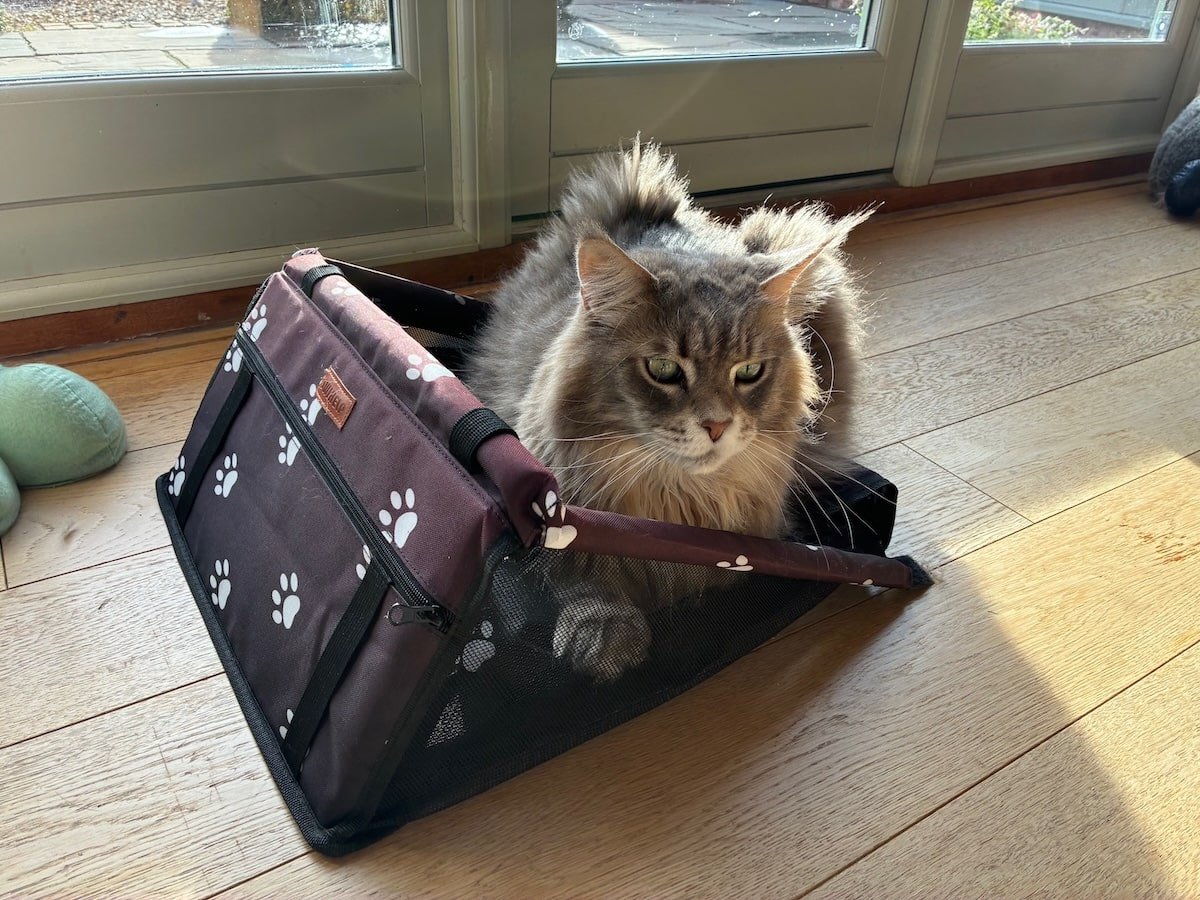Maine Coon Grooming Guide: Coat Care, Bathing, Nails & More

Maine Coons require more grooming than most cats, but understanding their coat, shedding cycle, and basic hygiene needs makes caring for them simple.
This guide provides a comprehensive overview of everything owners need to know about brushing, bathing, mats, nail trimming, paw tufts, ear care, and overall cleanliness. Each section includes a brief introduction, followed by helpful links to in-depth Maine Coon Central articles for owners who want a deeper dive.
How Often Should You Groom A Maine Coon?
Maine Coons have a dense, semi-long double coat designed for harsh winters. This means they shed year-round, with heavier seasonal moults in spring and autumn.
Most owners will only need to groom their cat 2-3 times per week, but during shedding season, brushing may be needed daily to prevent tangles and reduce hairballs.
Regular grooming also prevents matting, keeps natural oils balanced, and helps you spot skin conditions early. If your Maine Coon spends time outdoors or has a thicker ruff and undercoat, you may need a slightly more intensive routine.
Owners often underestimate how quickly tiny knots form behind the armpits, around the chest, or along the trousers.
For a breakdown of grooming frequency and whether your cat’s coat needs extra help, read:
• Top 13 Maine Coon Grooming Methods
• 9 Useful Maine Coon Grooming Tips
Brushing Your Maine Coon’s Coat
Brushing is the most important grooming step, preventing mats, removing loose hair, and keeping the coat clean.
Maine Coons usually tolerate grooming well, especially if introduced slowly using positive reinforcement. Start with wide-toothed combs for detangling, then switch to slicker brushes or grooming rakes for deep undercoat maintenance.
Focus on high-risk matting zones:
- Behind the legs
- Belly
- Flanks
- Ruff
Use slow, gentle strokes, and avoid pulling on knots, as this can damage the coat and cause pain. If your cat dislikes brushing, break the session into 2–3 short segments instead of one long one.
For deeper guidance on coat care and which tools work best, visit:
• 5 Brushes For Maine Coons That Work!
• 7 Proven Strategies To Prevent Matted Fur In Maine Coons
• Causes Of Crazy Maine Coon Shedding & How To STOP It!
Bathing Your Maine Coon
Maine Coons usually don’t need frequent baths, because their coat naturally repels dirt. That said, some owners choose to bathe their cat every few months to:
- Reduce shedding
- Remove excess oils
- Help with allergies
If your Maine Coon enjoys water (many do), bathing becomes much easier.
Always use cat-safe shampoos, avoid the face and ears, and make sure the coat is fully dried to prevent mildew and matting. A warm towel and gentle blow-dry on cool settings work best.
Never use human shampoos or products containing fragrances, alcohols, or essential oils.
To explore bathing techniques and recommended shampoos, see:
• How To Bathe A Maine Coon – Step By Step
Trimming Nails & Paw Tufts
Regular nail trimming prevents your Maine Coon from snagging, splitting claws, or causing accidental scratches. Many owners trim nails every 2-3 weeks, depending on how quickly their cat’s claws grow.
Use cat-safe clippers, support the paw gently, and trim only the transparent tip – never the pink quick.
Maine Coons often have long paw tufts between their toes, which help them walk on snow. Some owners trim these for hygiene, especially if their cat tracks litter or mud through the house. A small, careful trim can reduce slipping on hard floors and keep paws clean.
For tools and paw-care help, visit:
• 4 Nail Clippers Maine Coon Owners Swear By…
• Trimming Maine Coon Paw Tufts The Right Way!
Dealing With Mats & Tangles
Mats occur when knots bind tightly against the skin. If ignored, they become painful and may require professional grooming or partial shaving.
Maine Coons commonly develop mats:
- Behind their armpits
- Under their collar area
- Along their trousers
To remove small tangles, use a detangling comb or gently work through the knot with your fingers. Never use scissors near the skin – they can cause serious injury.
For severe or densely packed mats, a professional groomer may recommend a lion cut or partial shave to prevent skin trauma.
For full guidance on mat removal and shaving options, take a look at:
• 7 Proven Strategies To Prevent Matted Fur In Maine Coons
• Shaving Maine Coon Cats | Advice, Risks & Tips
• Maine Coon Lion Cuts: Dangers & Benefits
Cleaning Ears, Eyes, And Teeth
Basic hygiene goes beyond coat care since Maine Coons can be prone to:
- Wax buildup
- Tear staining
- Dental issues
Weekly ear checks help detect mites, inflammation, or excessive wax.
Clean only the visible outer ear flap – never insert anything into the ear canal.
For eye care, gently remove debris using a damp cotton pad.
Dental care is essential for preventing gum disease, tartar, and tooth loss. Brush your Maine Coon’s teeth several times a week using cat-safe toothpaste, and provide dental treats or chews to support oral hygiene.
For deeper help on hygiene care:
• 4 Best Cat Ear Drops | Infection, Wax & Mites
• Maine Coon Teeth Problems
• Maine Coon Tooth Loss
Maine Coon Grooming & Care FAQs
How often should you groom a Maine Coon?
Most need brushing 2-3 times weekly, increasing to daily during shedding seasons.
Do Maine Coons need regular baths?
Bathing is optional but helpful for shedding, oil control, or allergies.
How do I remove mats safely?
Use a detangling comb or fingers; severe mats require a groomer.
Do Maine Coons need their nails trimmed?
Yes, usually every 2-3 weeks to prevent overgrowth and splitting.
How do you clean a Maine Coon’s ears?
Wipe only the outer ear with a vet-approved ear solution – never go deeper.
